
Avernus was an ancient name for a volcanic crater near Cumae (Cuma), Italy, in the region of Campania west of Naples. Part of the Phlegraean Fields of volcanoes, Avernus is approximately 3.2 kilometres (2.0 mi) in circumference. Within the crater is Lake Avernus.
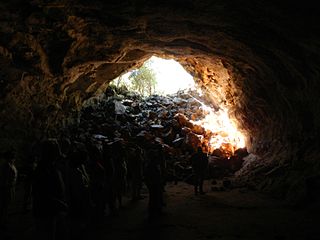
The Undara Volcanic National Park is a national park in the Shire of Etheridge, Queensland, Australia. It is situated 275 kilometres southwest of Cairns just off the Gulf Developmental Road. The park was established in 2009 to protect Australia's longest lava tube and the unique fauna and flora found of the area. The basalts of the area form part of the Cenozoic McBride Basalt (Volcanic) Provence. The volcanics are all less than 8 million years old (Ma) with the youngest only 7,000 years old.

Mount Erebus is the second-highest volcano in Antarctica, the highest active volcano in Antarctica, and the southernmost active volcano on Earth. It is the sixth-highest peak of an island and the second most prominent mountain in Antarctica after Mount Vinson. It has a summit elevation of 3,794 metres (12,448 ft). It is located in the Ross Dependency on Ross Island, which is also home to three inactive volcanoes: Mount Terror, Mount Bird, and Mount Terra Nova. The mountain was named by Captain James Clark Ross in 1841 for his ship, the Erebus.

Mount Etna, or simply Etna, is an active stratovolcano on the east coast of Sicily, Italy, in the Metropolitan City of Catania, between the cities of Messina and Catania. It is located above the convergent plate margin between the African Plate and the Eurasian Plate. It is one of the tallest active volcanoes in Europe, and the tallest peak in Italy south of the Alps with a current height of 3,357 m (11,014 ft), though this varies with summit eruptions. Over a six-month period in 2021, Etna erupted so much volcanic material that its height increased by approximately 100 ft (30 m), and the southeastern crater is now the tallest part of the volcano.

Lava Beds National Monument is located in northeastern California, in Siskiyou and Modoc counties. The monument lies on the northeastern flank of Medicine Lake Volcano, which is the largest volcano by area in the Cascade Range.

Craters of the Moon National Monument and Preserve is a U.S. national monument and national preserve in the Snake River Plain in central Idaho. It is along US 20, between the small towns of Arco and Carey, at an average elevation of 5,900 feet (1,800 m) above sea level.

Sunset Crater is a cinder cone located north of Flagstaff in the U.S. state of Arizona. The crater is within the Sunset Crater Volcano National Monument.

Masaya is a caldera located in Masaya, Nicaragua, 20 km (12 mi) south of the capital Managua. It is Nicaragua's first and largest national park, and one of 78 protected areas of Nicaragua. The complex volcano is composed of a nested set of calderas and craters, the largest of which is Las Sierras shield volcano and caldera. Within this caldera lies a sub-vent, which is Masaya Volcano sensu stricto. The vent is a shield type composing of basaltic lavas and tephras and includes a summit crater. This hosts Masaya caldera, formed 2,500 years ago by an 8 km3 (1.9 cu mi) basaltic ignimbrite eruption. Inside this caldera a new basaltic complex has grown from eruptions mainly on a semi-circular set of vents that include the Masaya and Nindiri cones. The latter host the pit craters of Masaya, Santiago, Nindiri and San Pedro. Observations in the walls of the pit craters indicate that there have been several episodes of cone and pit crater formation.
The "Well to Hell" is an urban legend regarding a putative borehole in Russia which was purportedly drilled so deep that it broke through into Hell. It is first attested in English as a 1989 broadcast by a U.S. domestic religion-based TV broadcaster, Trinity Broadcasting Network.
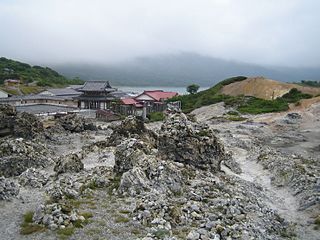
Mount Osore is the name of a Buddhist temple and folk religion pilgrimage destination in the center of remote Shimokita Peninsula of Aomori Prefecture, in the northern Tōhoku region of northern Japan. The temple is located in the caldera of an active volcano and is believed in Japanese mythology to be one of the gates to the underworld.

Villarrica is one of Chile's most active volcanoes, rising above the lake and town of the same name, 750 km (470 mi) south of Santiago. It is also known as Rucapillán, a Mapuche word meaning "great spirit's house" or " the demon's house". It is the westernmost of three large stratovolcanoes that trend northwest to southeast obliquely perpendicular to the Andean chain along the Mocha-Villarrica Fault Zone, and along with Quetrupillán and the Chilean portion of Lanín, are protected within Villarrica National Park. Guided ascents are popular during summer months.

Stull is an unincorporated community in Douglas County, Kansas, United States. Founded in 1857, the settlement was initially known as Deer Creek until it was renamed after its only postmaster, Sylvester Stull. As of 2018, only a handful of structures remain in the area.
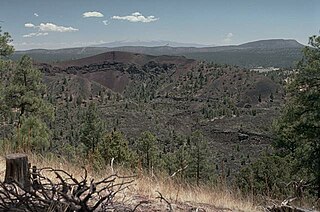
Zuni-Bandera volcanic field is a volcanic field located in the state of New Mexico, United States.

Darvaza is a rural council in Ak bugdaý District, Ahal Province, Turkmenistan of about 2 thousand inhabitants, located in the middle of the Karakum Desert, about 260 km north of Ashgabat. The rural council consists of three separate villages: Derweze, Ataguýy, and Böri.

A lava cave is any cave formed in volcanic rock, though it typically means caves formed by volcanic processes, which are more properly termed volcanic caves. Sea caves, and other sorts of erosional and crevice caves, may be formed in volcanic rocks, but through non-volcanic processes and usually long after the volcanic rock was emplaced.
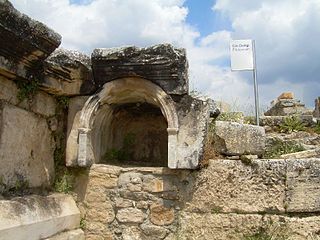
A ploutonion is a sanctuary specially dedicated to the ancient Greek god Plouton. Only a few such shrines are known from classical sources, usually at locations that produce poisonous emissions and were considered to represent an entrance to the underworld.

The Darvaza gas crater, also known as the Door to Hell or Gates of Hell, or, officially, the Shining of Karakum, is a burning natural gas field collapsed into a cavern near Darvaza, Turkmenistan. Hundreds of natural gas fires illuminate the floor and rim of the crater. The crater has been burning since the 1980s. How the crater formed is unknown, but engineers ignited the crater to prevent poisonous gases from spreading.

The Ploutonion at Hierapolis or Pluto's Gate was a ploutonion in the ancient city of Hierapolis near Pamukkale in modern Turkey's Denizli Province. The site was discovered in 1965 by Italian archaeologists, who published reports on their excavations throughout the decade. Following the studies carried out on site in 1998, a geologist of the Italian National Research Council, Luigi Piccardi, recognized that the origin of both the Ploutonion and of the nearby Apollo's Oracle of Hierapolis was linked to the existence of the surface trace of a seismic fault, on which both sanctuaries were purposely built and which was revered as Gateway of Hades. In 2013, it was further explored by Italian archaeologists led by Francesco D'Andria, a professor of archaeology at the University of Salento. As part of a restoration project, a replica of the marble statue of Hades and Cerberus has been restored to its original place. The statue is known to have been there in ancient times.
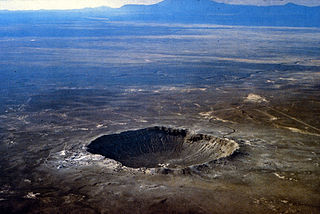
A crater is a landform consisting of a hole or depression on a planetary surface, usually caused either by an object hitting the surface, or by geological activity on the planet. A crater has classically been described as: "a bowl-shaped pit that is formed by a volcano, an explosion, or a meteorite impact". On Earth, craters are "generally the result of volcanic eruptions", while "meteorite impact craters are common on the Moon, but are rare on Earth".

Bandera Volcano Ice Cave, also known as Zuni Ice Cave, is a lava tube cave in New Mexico with an internal temperature significantly less than above-ground summertime ambient temperature; it contains perennial ice. The inside temperatures can fluctuate between −1 and 10 °C. Some areas of the ice cave never reach above freezing. For years, local Indigenous people used the cave to store food.
























